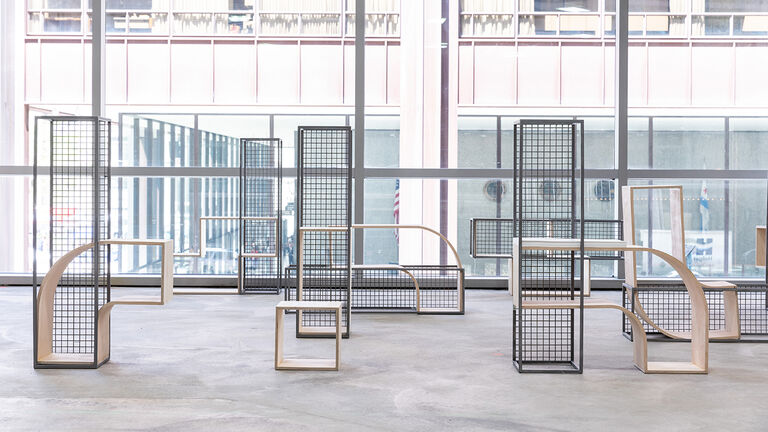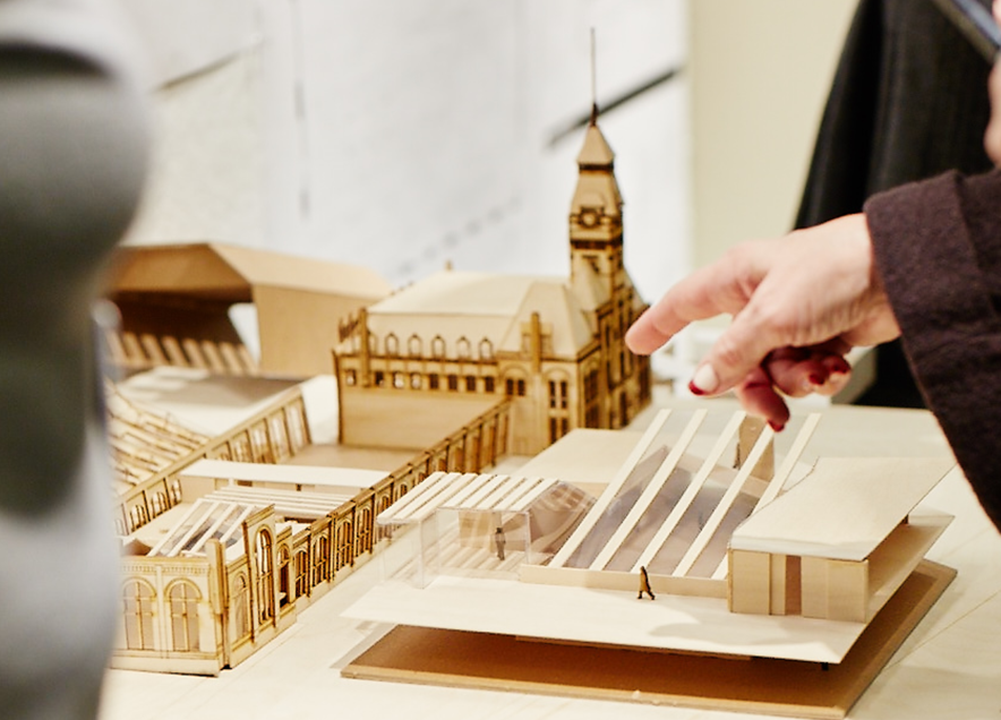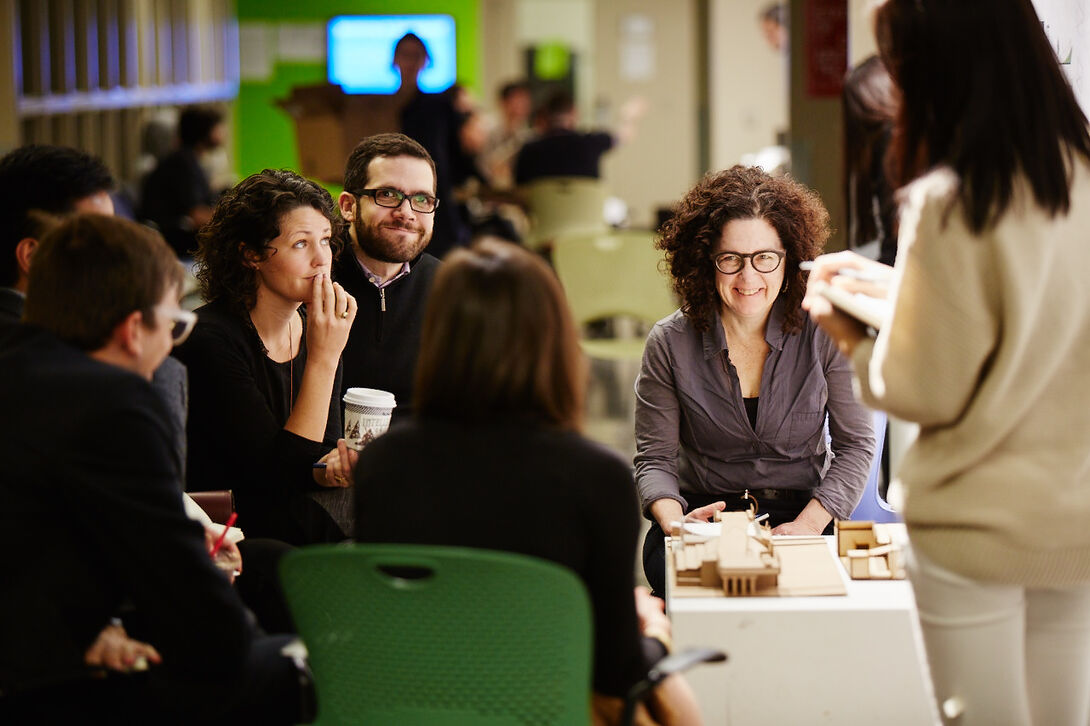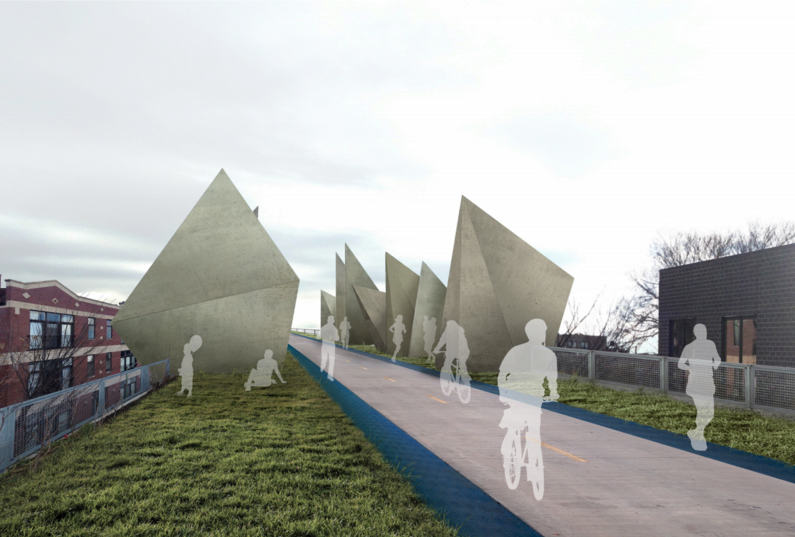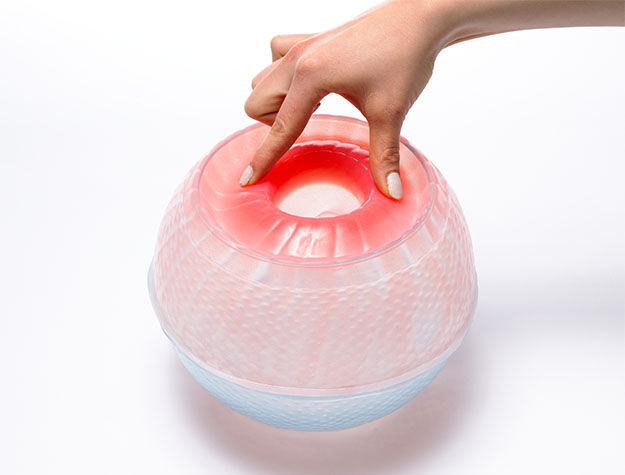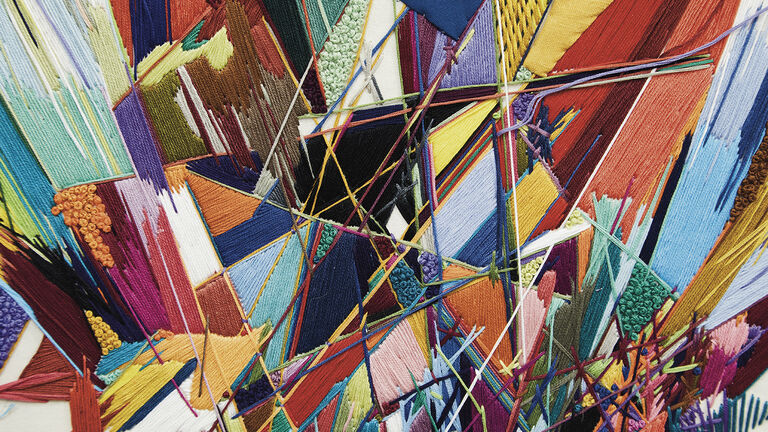| Introduction to Architecture/Interior Architecture |
1001 (001) |
Aaron Neal |
Wed
9:00 AM - 3:00 PM
In Person
|
|
Description
Introduces the meaning and making of architecture and interior architecture through individual and group design projects. Students learn design processes by experimenting with materials and exploring architectural and interior architecture representation, and measure the implications of their work on broader cultural contexts. Students work on design projects using the latest software and digital tools, and develop techniques for integrating analog and digital design and fabrication processes. Students research historic precedents and contemporary culture and design to inform their work. This course requires students to have a laptop that meets SAIC's minimum hardware specs and runs the AIADO template.
|
Class Number
1045
|
Credits
3
|
Department
Architecture, Interior Architecture, and Designed Objects
Location
Sullivan Center 1256
|
| Introduction to Designed Objects |
1001 (001) |
Cassandra Scanlon |
Mon
9:00 AM - 3:00 PM
In Person
|
|
Description
This course introduces students to the creative scope of the Designed Objects program, and the ideas, skills, and methods used in the process of designing objects. Students will learn about the design of objects by studying their form, function, assembly, materiality, use, value and significance (both subjective and objective). Emphasizing thinking through making; students students build their visual vocabulary and develop an understanding of the design process. The goal of this class is to help students imagine the possibilities of the object design field and identify their aptitude for becoming an object designer. The course will explore the intentionality of object design, exploring the works of a ranging from James Dyson to Ron Arad to Zaha Hadid. Readings and screenings will vary but typically include Mu-Ming Tsai's Design Thinking and Gary Hustwit's Objectified. Students should expect to produce a body of work consisting of several minor exploratory projects and two fully fleshed out finished Objects (mid-term and final). This course requires students to have a laptop that meets SAIC's minimum hardware specs and runs the AIADO template.
|
Class Number
1379
|
Credits
3
|
Department
Architecture, Interior Architecture, and Designed Objects
Area of Study
Product Design
Location
Sullivan Center 1256
|
| Introduction to Architecture/Interior Architecture |
1001 (002) |
|
Tues
9:00 AM - 3:00 PM
In Person
|
|
Description
Introduces the meaning and making of architecture and interior architecture through individual and group design projects. Students learn design processes by experimenting with materials and exploring architectural and interior architecture representation, and measure the implications of their work on broader cultural contexts. Students work on design projects using the latest software and digital tools, and develop techniques for integrating analog and digital design and fabrication processes. Students research historic precedents and contemporary culture and design to inform their work. This course requires students to have a laptop that meets SAIC's minimum hardware specs and runs the AIADO template.
|
Class Number
1046
|
Credits
3
|
Department
Architecture, Interior Architecture, and Designed Objects
Location
Sullivan Center 1226
|
| Introduction to Designed Objects |
1001 (002) |
Sara Prado |
Wed
9:00 AM - 3:00 PM
In Person
|
|
Description
This course introduces students to the creative scope of the Designed Objects program, and the ideas, skills, and methods used in the process of designing objects. Students will learn about the design of objects by studying their form, function, assembly, materiality, use, value and significance (both subjective and objective). Emphasizing thinking through making; students students build their visual vocabulary and develop an understanding of the design process. The goal of this class is to help students imagine the possibilities of the object design field and identify their aptitude for becoming an object designer. The course will explore the intentionality of object design, exploring the works of a ranging from James Dyson to Ron Arad to Zaha Hadid. Readings and screenings will vary but typically include Mu-Ming Tsai's Design Thinking and Gary Hustwit's Objectified. Students should expect to produce a body of work consisting of several minor exploratory projects and two fully fleshed out finished Objects (mid-term and final). This course requires students to have a laptop that meets SAIC's minimum hardware specs and runs the AIADO template.
|
Class Number
1387
|
Credits
3
|
Department
Architecture, Interior Architecture, and Designed Objects
Area of Study
Product Design
Location
Sullivan Center 1255
|
| Introduction to Architecture/Interior Architecture |
1001 (003) |
|
Thurs
9:00 AM - 3:00 PM
In Person
|
|
Description
Introduces the meaning and making of architecture and interior architecture through individual and group design projects. Students learn design processes by experimenting with materials and exploring architectural and interior architecture representation, and measure the implications of their work on broader cultural contexts. Students work on design projects using the latest software and digital tools, and develop techniques for integrating analog and digital design and fabrication processes. Students research historic precedents and contemporary culture and design to inform their work. This course requires students to have a laptop that meets SAIC's minimum hardware specs and runs the AIADO template.
|
Class Number
1047
|
Credits
3
|
Department
Architecture, Interior Architecture, and Designed Objects
Location
Sullivan Center 1230
|
| Introduction to Architecture/Interior Architecture |
1001 (005) |
Mary Begley |
Mon
9:00 AM - 3:00 PM
In Person
|
|
Description
Introduces the meaning and making of architecture and interior architecture through individual and group design projects. Students learn design processes by experimenting with materials and exploring architectural and interior architecture representation, and measure the implications of their work on broader cultural contexts. Students work on design projects using the latest software and digital tools, and develop techniques for integrating analog and digital design and fabrication processes. Students research historic precedents and contemporary culture and design to inform their work. This course requires students to have a laptop that meets SAIC's minimum hardware specs and runs the AIADO template.
|
Class Number
1056
|
Credits
3
|
Department
Architecture, Interior Architecture, and Designed Objects
Location
Sullivan Center 1255
|
| Arch/Inarch: Design Drawing |
1002 (001) |
Adel Machacca |
Fri
9:00 AM - 3:00 PM
In Person
|
|
Description
This course is a comprehensive introduction to two-dimensional architectural and interior architectural representation. Students learn hand-drawing and digital techniques to produce orthographic, axonometric, isometric, and perspectival projections in individual and group projects. Students move between two- and three-dimensional representation, developing robust skills for design drawing. Typically the course will review the work of architects and designers throughout the history of architecture representation. Readings will vary and focus will be concentrated on understanding and putting into practice the mechanisms of drawing. Course work consists of building techniques and practice of drawing. Classes will develop incremental skills through assignments and projects that culminate into complex drawings and representations. This course requires students to have a laptop that meets SAIC's minimum hardware specs and runs the AIADO template.
|
Class Number
1049
|
Credits
3
|
Department
Architecture, Interior Architecture, and Designed Objects
Area of Study
Digital Communication
Location
Sullivan Center 1255
|
| Design Communication |
1004 (001) |
Mary Begley |
Tues
3:30 PM - 9:15 PM
In Person
|
|
Description
Comprehensive introduction to three-dimensional architectural and interior architectural representation and fabrication. Through individual and group projects, students learn hand-modeling and digital fabrication techniques, and become super-users of the School?s shops and Advanced Output Center. Students work on design projects using the latest software and digital tools, and develop techniques for integrating analog and digital design and fabrication processes. Students move between two- and three-dimensional representation in the development of robust skills for design communication. This course requires students to have a laptop that meets SAIC's minimum hardware specs and runs the AIADO template.
|
Class Number
1040
|
Credits
3
|
Department
Architecture, Interior Architecture, and Designed Objects
Area of Study
Digital Communication, Digital Imaging
Location
Sullivan Center 1240
|
| Arch/Inarch: Undergraduate Studio 1 |
2001 (001) |
|
Mon/Wed
9:00 AM - 3:00 PM
In Person
|
|
Description
This two-day core design studio is the introductory course in the Arch/Inarc core studio sequence. Students learn architecture and interior architecture design processes including precedent research, formal analysis, schematic design, and design development, all using the latest software and tools. This course exemplifies the rigorous model of the architecture studio. It encourages design experimentation and provides an analytic framework for developing an advanced understanding of how drawing and model making shape design processes. This course requires students to have a laptop that meets SAIC's minimum hardware specs and runs the AIADO template.
Prerequisites
Prerequisite: ARCH/INARC 1001 or DES OB 1001
|
Class Number
1050
|
Credits
6
|
Department
Architecture, Interior Architecture, and Designed Objects
Location
Sullivan Center 1406B
|
| Arch/Inarch: Undergraduate Studio 1 |
2001 (002) |
Jonathan Solomon |
Mon/Wed
9:00 AM - 3:00 PM
In Person
|
|
Description
This two-day core design studio is the introductory course in the Arch/Inarc core studio sequence. Students learn architecture and interior architecture design processes including precedent research, formal analysis, schematic design, and design development, all using the latest software and tools. This course exemplifies the rigorous model of the architecture studio. It encourages design experimentation and provides an analytic framework for developing an advanced understanding of how drawing and model making shape design processes. This course requires students to have a laptop that meets SAIC's minimum hardware specs and runs the AIADO template.
Prerequisites
Prerequisite: ARCH/INARC 1001 or DES OB 1001
|
Class Number
1051
|
Credits
6
|
Department
Architecture, Interior Architecture, and Designed Objects
Location
Sullivan Center 1406A
|
| Sketching for Designed Objects |
2005 (001) |
John C Beierle |
Tues
9:00 AM - 3:00 PM
In Person
|
|
Description
This course will provide the student with the skills to create design concept sketches (ideation/thinking) that will communicate with the viewer and visualize the design concept as a design object using sketch renderings to define and communicate the object's form and function. Instructions will focus on freehand marker sketching for ideation/thumbnails, shading, form development and rendering, followed by orthographic projection (measured technical drawing) and two-point perspective. Each of these skills will be demonstrated in class and on a one to one basis during the semester In each class I will share design drawings from my collection that show a history of sketching styles for presentations using Prismacolor Pencils and NuPastels to markers, along with marker drawings for clients that I and other designers have created in product, packaging and display projects. These presentations will also be used to lecture on the history of design drawing styles and techniques. Students will be given three design projects in which they will go through the design process of starting with ideation sketches, followed by design selection, renderings and an orthographic drawing of the final design. The first project focuses on the development of forms, the next two projects have an emphasis on ideas and drawing skills. This course requires students to have a laptop that meets SAIC's minimum hardware specs and runs the AIADO template.
|
Class Number
1380
|
Credits
3
|
Department
Architecture, Interior Architecture, and Designed Objects
Area of Study
Product Design
Location
Sullivan Center 1241
|
| Sketching for Designed Objects |
2005 (002) |
|
Mon/Wed
6:45 PM - 9:15 PM
In Person
|
|
Description
This course will provide the student with the skills to create design concept sketches (ideation/thinking) that will communicate with the viewer and visualize the design concept as a design object using sketch renderings to define and communicate the object's form and function. Instructions will focus on freehand marker sketching for ideation/thumbnails, shading, form development and rendering, followed by orthographic projection (measured technical drawing) and two-point perspective. Each of these skills will be demonstrated in class and on a one to one basis during the semester In each class I will share design drawings from my collection that show a history of sketching styles for presentations using Prismacolor Pencils and NuPastels to markers, along with marker drawings for clients that I and other designers have created in product, packaging and display projects. These presentations will also be used to lecture on the history of design drawing styles and techniques. Students will be given three design projects in which they will go through the design process of starting with ideation sketches, followed by design selection, renderings and an orthographic drawing of the final design. The first project focuses on the development of forms, the next two projects have an emphasis on ideas and drawing skills. This course requires students to have a laptop that meets SAIC's minimum hardware specs and runs the AIADO template.
|
Class Number
1393
|
Credits
3
|
Department
Architecture, Interior Architecture, and Designed Objects
Area of Study
Product Design
Location
Sullivan Center 1407
|
| Arch/Inarch: Color and Space |
2008 (001) |
Stephanie Slaughter |
Wed
9:00 AM - 3:00 PM
In Person
|
|
Description
This one-day studio focuses on colors infinite influence on the human experience and the lived environment. Color interpretation and cultural connectivity will enable students through rigorous representation techniques, and experiments develop a personal color sensibility. Color palettes are examined to distinguish critical and creative thinking in design. Color Theory is studied to identify atmosphere and spaces that affect each of us both psychologically and physiologically. Principles of color usage is explored, how it effects form, light and material. Some relevant topics we will study include Color and Culture, how people experience their environment through the senses, time, emotions and spatial awareness. Color and Light inseparable partners in the process of perception forming part of the overall design of space. Color, Material and Structure (CMS) are experienced through two important senses, sight and touch. The effectiveness of CMS in design depends upon its relationship to form, also recognizing that materials and finishes, whether glass, granite or paint, contribute color to all space. Some scholars we will study include Josef Albers, Albert Munsell, and Joann and Arielle Eckstut. The deliverables for the class are precedent research, in-class assignments, relevant readings, Mid-term Project presentation and Final Studio Project presentation at the site presented to the clients.
|
Class Number
1052
|
Credits
3
|
Department
Architecture, Interior Architecture, and Designed Objects
Location
Sullivan Center 1241
|
| What's Worth Preserving? |
2010 (001) |
Jonathan Solomon |
Tues
9:00 AM - 3:00 PM
In Person
|
|
Description
Architectural preservation, art conservation, archiving and collecting, even environmental protection: all these practices share a desire to preserve things of value, but how do we decide what's valuable? Using the laws, policies, and practices of architectural preservation as a starting point this studio will ask and propose answers to the question: what's worth preserving? Students will explore how preservation practice overlaps and complements the work of different museums, archives, and collections that define value and how they protect it; and propose strategies for assembling and maintaining their own collections in whatever media they choose. Course readings will focus on the history and contemporary practice of preservation, conservation, and collecting, including texts by Ariella Aisha Azoulay, Daniel Bluestone, Amanda Cachia and Alice Wong, the De-Colonial Collective on Migration of Objects and People, Shannon Mattern, and Jacqueline Hoang Nguyen, Jorge Otero-Pailos, Leah Samples, The South Side Home Movie Project. Course work will include weekly readings and in-class discussions and lectures. Students will work individually throughout the course to research how different institutions assemble and protect their collections, identify a subject of personal interest for preservation, and propose a preservation strategy for it in any medium of their choice.
|
Class Number
2312
|
Credits
3
|
Department
Architecture, Interior Architecture, and Designed Objects
Area of Study
Art/Design and Politics, Community & Social Engagement, Public Space, Site, Landscape
Location
Sullivan Center 1255
|
| Designing Interaction |
2019 (001) |
George Guffey |
Thurs
3:30 PM - 9:15 PM
In Person
|
|
Description
This core skills studio teaches how to generate impactful visual materials to effectively communicate interactions with objects, digital interfaces and within virtual spaces. Students will learn professional communication tools for prototyping screen-based interfaces, vector illustration, typographic and visual composition, and data visualization. As well as aiding design development, the tools covered will enable the successful communication of storyboarded scenarios, design research, and finished proposals for physical and screen-based presentation. This course requires students to have a laptop that meets SAIC's minimum hardware specs and runs the AIADO template.
|
Class Number
2157
|
Credits
3
|
Department
Architecture, Interior Architecture, and Designed Objects
Area of Study
Digital Communication
Location
Sullivan Center 1241
|
| Designed Objects Studio One |
2020 (001) |
Eric Allan Hotchkiss |
Thurs
9:00 AM - 3:00 PM
In Person
|
|
Description
As the beginning course in the Designed Objects department, students will have an opportunity to explore different methods of working in order to begin establishing a practice that works best for them. Students will be building a strong foundation of skills and techniques needed to navigate an informed design process and successfully complete a design brief. In this hands-on class, students will learn how to find inspiration for an idea, develop that idea into a concept, and use that concept to design and fabricate a high-level, final prototype. Basic research theories and methods are introduced which are then applied towards studio projects. Fabrication and prototyping techniques are also incorporated in order to test out ideas and discover new ones. Students advance through definition, research, ideation, sketching, and modeling phases toward two? and three?dimensional representations (digital and physical) of their work that are orally defended during group critique. Readings and lecture content will vary and will focus on examples of historically relevant and contemporary designers, artists, studios, and design movements; as well as design practices that highlight different motivations of the designer. In addition to the two main projects that focus on different methods of approaching design? where students will be producing high-level prototypes, this workshop-style class consists of one-day projects and exercises designed to introduce techniques and skills such as technical drawing and sketching, form-finding, prototyping, and inspiration research, among others. This course requires students to have a laptop that meets SAIC's minimum hardware specs and runs the AIADO template.
Prerequisites
Prerequisite: Sophomore-level or above.
|
Class Number
1381
|
Credits
3
|
Department
Architecture, Interior Architecture, and Designed Objects
Area of Study
Product Design
Location
Sullivan Center 1255
|
| Designed Objects Studio One |
2020 (002) |
James TerMeer |
Tues
9:00 AM - 3:00 PM
In Person
|
|
Description
As the beginning course in the Designed Objects department, students will have an opportunity to explore different methods of working in order to begin establishing a practice that works best for them. Students will be building a strong foundation of skills and techniques needed to navigate an informed design process and successfully complete a design brief. In this hands-on class, students will learn how to find inspiration for an idea, develop that idea into a concept, and use that concept to design and fabricate a high-level, final prototype. Basic research theories and methods are introduced which are then applied towards studio projects. Fabrication and prototyping techniques are also incorporated in order to test out ideas and discover new ones. Students advance through definition, research, ideation, sketching, and modeling phases toward two? and three?dimensional representations (digital and physical) of their work that are orally defended during group critique. Readings and lecture content will vary and will focus on examples of historically relevant and contemporary designers, artists, studios, and design movements; as well as design practices that highlight different motivations of the designer. In addition to the two main projects that focus on different methods of approaching design? where students will be producing high-level prototypes, this workshop-style class consists of one-day projects and exercises designed to introduce techniques and skills such as technical drawing and sketching, form-finding, prototyping, and inspiration research, among others. This course requires students to have a laptop that meets SAIC's minimum hardware specs and runs the AIADO template.
Prerequisites
Prerequisite: Sophomore-level or above.
|
Class Number
1397
|
Credits
3
|
Department
Architecture, Interior Architecture, and Designed Objects
Area of Study
Product Design
Location
Sullivan Center 1240
|
| Interface Design Seminar |
2028 (001) |
George Guffey |
Tues
6:45 PM - 9:30 PM
In Person
|
|
Description
'You are not the user. As objects become 'smart,' a designer should not only think about its form but also think about how others will interface with it. These days, a user can interact directly with an object, talk to an object, or interact remotely through a smartphone or hub. It is also important that the designer has a general understanding of the technology that makes an object ?smart? and how that can be used to construct a desired experience. Through presentations and discussions, this studio-seminar rapidly introduces methods to understand objects, technology and their relationship with users. Projects in this class can also explore how an app can be used to enhance an object and not replace it. Weekly presentations will focus on various interface technologies or user interface (UI) development methods and examples that will be explored in the assignments. Work examples will consist of both historic and current objects as well as samples of professional work. Suggested readings: 'Enhanced Objects' by David Rose, 'Don't Make Me Think Revisited' by Steve Krug, and the writings of Donald Norman. Over the course of the semester, students can expect to produce at least two different interface projects. Weekly assignments will explore various steps in a UI development process such as persona development, flow diagramming, graphic design, iconography, typography, concept simulation, and user testing. The assignments and projects will be reviewed and critiqued with the class. Please note that this is not a programming class, and the projects only require the development of a simulated interface.
Prerequisites
Prerequisite: Sophomore-level or above.
|
Class Number
1388
|
Credits
3
|
Department
Architecture, Interior Architecture, and Designed Objects
Area of Study
Digital Communication, Product Design
Location
Sullivan Center 1407
|
| Designed Objects Studio Two |
2030 (001) |
Annalee Koehn |
Thurs
9:00 AM - 3:00 PM
In Person
|
|
Description
We will work with the processes by which product designers develop compelling objects that communicate ideas, values, functions and purpose. Projects are designed to study the language of form through an analysis of user interaction, the implications of material choice, finishes, and craftsmanship on the success of a product concept, and how these choices support and promote function, desirability and perceived value. There is also an emphasis on expanding student material exploration and making techniques for optimal results, and the value of iterative prototyping in a successful design process. The course will address universal product design issues and methods, starting with defining and understanding the project, considering form and function, appropriate material selection, construction techniques, finishes, iteration, and well-crafted final products. We will cover concepts such as semiotics, ergonomics, families of objects, multi-functional products, and emphasize clear communication of finished design ideas through schematics, and graphic representation using descriptive photography. Relevant contemporary design examples are provided as reference for each project, and students will spend additional time researching contemporary designers such as Front Design, Raw Edges, Nendo and Ron Arad. Students will be introduced to high-end professional design sources in a business setting through a field trip to the Merchandise Mart. The course is built around 3 main projects, each with instructional presentations, Design research assignments, ideation and sketching, group discussions, and iterative prototyping, resulting in the creation of a final product and printed graphic document, all presented and discussed in a group critique. This course requires students to have a laptop that meets SAIC's minimum hardware specs and runs the AIADO template.
Prerequisites
Pre Req: DES OB 2020
|
Class Number
1382
|
Credits
3
|
Department
Architecture, Interior Architecture, and Designed Objects
Area of Study
Product Design
Location
Sullivan Center 1240
|
| Sustainability Studio |
2035 (001) |
Peter J Zerillo |
Tues
3:30 PM - 6:15 PM
In Person
|
|
Description
This course provides an introduction to sustainable design, covering topics such as raw materials, energy, food, water, global and local production, global supply chain, green chemistry, and circular economies. Students will learn about the three pillars of sustainability and the fundamental concepts and principles of sustainability. The course will cover the importance of renewable resources and closed-loop systems to reduce waste in sustainable design. Students will explore renewable energy sources and energy-efficient technologies. The importance of food and water in sustainable design, global and local production systems, the precautionary principle, and the ethical sourcing of materials will also be covered. The course will examine green chemistry as a means of reducing the environmental impact of chemical processes. Finally, students will learn about circular economies and the importance of designing products and processes that promote the reuse and recycling of materials. By the end of the course, students will be able to apply their knowledge of sustainable design principles and practices to their projects in and out of school.
Prerequisites
Prerequisite: Sophomore-level or above.
|
Class Number
2158
|
Credits
3
|
Department
Architecture, Interior Architecture, and Designed Objects
Area of Study
Product Design, Sustainable Design
Location
Sullivan Center 1241
|
